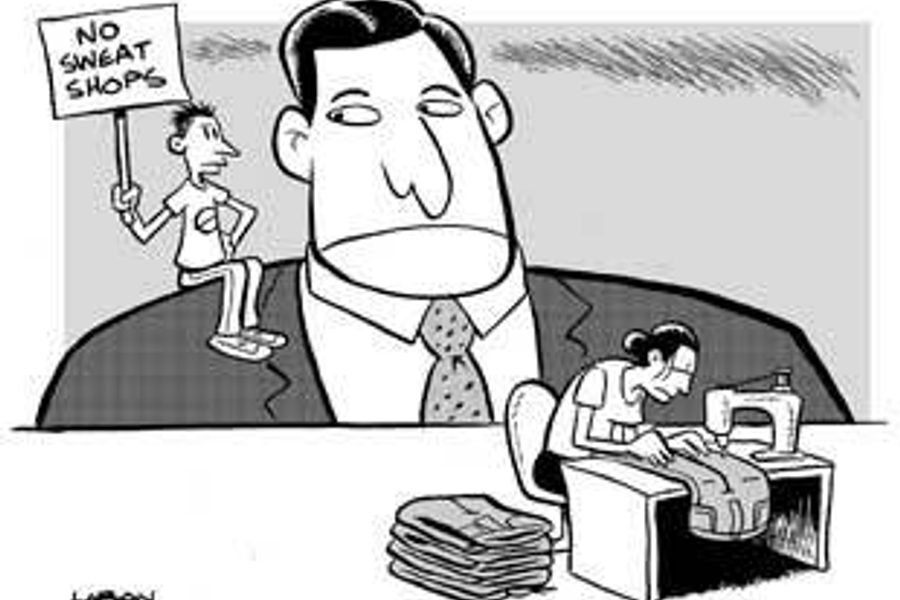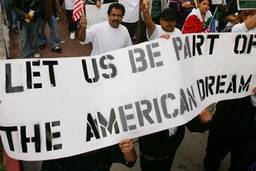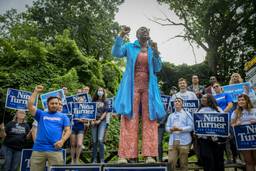
Student anti-sweatshop activism has come of age. Exercising substantial sway over corporate giants, it has helped overseas garment workers make unprecedented gains. But with many battles looming, some activists worry their momentum has peaked.
The signing of a collective bargaining agreement last March at the BJ&B hat factory in a Dominican Republic free-trade zone was particularly sweet for student campaigners. The illegal firing of union loyalists and grisly working conditions that came to light seven years ago at the factory launched the United Students Against Sweatshops (USAS), the force behind campus labor activism. It in turn helped establish the Worker Rights Consortium (WRC), an independent factory-monitoring group whose investigation spurred the resolution at BJ&B.
For the Dominican factory’s nearly 1,600 workers—the largest unionized free-trade zone factory in the Americas—the contract brings a wage above the country’s paltry minimum, college scholarships and other unparalleled benefits.
The BJ&B victory is exemplary, according to anti-corporate student activists, because without the intervention of the Fair Labor Association, the WRC’s more corporate-friendly doppelganger, and pressure from Nike and Reebok, workers at BJ&B would still be fighting harassment and summary firings.
Cooperation is the new watchword among students, monitoring groups and corporations. “We have a preference for cooperation because it leads to action more quickly,” says Scott Nova, executive director of the WRC. He notes that the group’s quiet intervention in two Indonesian factories recently prompted corporations to comply with health-benefit laws and to open the door to independent unions there.
“We don’t cooperate at the expense of independent analysis and candid assessment,” Nova says. “Cooperation is a means to an end, which is respecting workers rights.”
Students maintain that their dealings with corporations are a relationship of convenience. When brands fail to act, students work as the enforcement arm of the WRC, a role where their reputation precedes them.
“Corporations realized that organizations like USAS can hit them where it hurts most, in their public image,” says Megan Murphy, an anti-sweatshop activist and sophomore at Georgetown University.
The WRC has conducted 15 investigations in three years of operation. Most brands have accepted its evenhanded assessments of transgressions, while students and NGO partners on its board of directors keep the group honest. It has been a successful formula.
“The WRC isn’t out there to kick brands around or destroy their business,” says Ben McKean, a USAS national organizer. At the same time, “they know as a business decision it’s cheaper to make the changes the WRC is asking for. They know we have the power to kick their ass.”
Not every brand has learned that lesson. Collegiate apparel is a small fraction of the global garment industry, and while students wield the most power over brands dependent on college business, they are starting to lean on mass-market companies.
A developing campaign against Land’s End is at the heart of this trend. The company embroiders collegiate logos onto its clothes, a specialty practice aimed at alumni. But the company’s glacial pace in resolving the rampant blacklisting of unionists at the Primo factory in El Salvador’s San Bartolo free-trade zone led Columbia University to cut its contract last November with Land’s End.
As pressure builds, the company’s attitude is changing. Judi Nitsch, an Indiana University graduate student and member of her school’s worker rights committee, says after her committee threatened to cut the contract, Continued on page 52
Land’s End admitted their third-party inquiry misrepresented the situation and promised remediation. A Land’s End spokeswoman says the company is preparing a corrective plan, and declined further comment, pending an investigation.
In addition to targeting more diverse brands, anti-sweatshop campaigners are pushing campus worker rights committees to force corporate disclosure of factory wages.
Organizers expect a difficult battle, but their success in securing the release of factory locations three years ago emboldens them. Transparency in wages, they say, is the first step to raising the pay floor. “In some cases, getting companies to pay minimum wage would be progress—that’s how bad the industry is,” McKean says.
With the United States negotiating bilateral trade deals that weaken worker protections and with the Multi-Fiber Agreement—a World Trade Organization textile-quota system—expiring this year, industry observers predict garment production will flee to China and other countries with feeble civil societies and anti-union laws.
To combat these moves, says Nova, “we are going to make this debate about more than respect for rights in the workplace. If we are to see sustainable improvements in worker rights, buyers need to stick by and support those factories when they make improvements.”
The signing of a collective bargaining agreement last March at the BJ&B hat factory in a Dominican Republic free-trade zone was particularly sweet for student campaigners. The illegal firing of union loyalists and grisly working conditions that came to light seven years ago at the factory launched the United Students Against Sweatshops (USAS), the force behind campus labor activism. It in turn helped establish the Worker Rights Consortium (WRC), an independent factory-monitoring group whose investigation spurred the resolution at BJ&B.
For the Dominican factory’s nearly 1,600 workers—the largest unionized free-trade zone factory in the Americas—the contract brings a wage above the country’s paltry minimum, college scholarships and other unparalleled benefits.
The BJ&B victory is exemplary, according to anti-corporate student activists, because without the intervention of the Fair Labor Association, the WRC’s more corporate-friendly doppelganger, and pressure from Nike and Reebok, workers at BJ&B would still be fighting harassment and summary firings.
Cooperation is the new watchword among students, monitoring groups and corporations. “We have a preference for cooperation because it leads to action more quickly,” says Scott Nova, executive director of the WRC. He notes that the group’s quiet intervention in two Indonesian factories recently prompted corporations to comply with health-benefit laws and to open the door to independent unions there.
“We don’t cooperate at the expense of independent analysis and candid assessment,” Nova says. “Cooperation is a means to an end, which is respecting workers rights.”
Students maintain that their dealings with corporations are a relationship of convenience. When brands fail to act, students work as the enforcement arm of the WRC, a role where their reputation precedes them.
“Corporations realized that organizations like USAS can hit them where it hurts most, in their public image,” says Megan Murphy, an anti-sweatshop activist and sophomore at Georgetown University.
The WRC has conducted 15 investigations in three years of operation. Most brands have accepted its evenhanded assessments of transgressions, while students and NGO partners on its board of directors keep the group honest. It has been a successful formula.
“The WRC isn’t out there to kick brands around or destroy their business,” says Ben McKean, a USAS national organizer. At the same time, “they know as a business decision it’s cheaper to make the changes the WRC is asking for. They know we have the power to kick their ass.”
Not every brand has learned that lesson. Collegiate apparel is a small fraction of the global garment industry, and while students wield the most power over brands dependent on college business, they are starting to lean on mass-market companies.
A developing campaign against Land’s End is at the heart of this trend. The company embroiders collegiate logos onto its clothes, a specialty practice aimed at alumni. But the company’s glacial pace in resolving the rampant blacklisting of unionists at the Primo factory in El Salvador’s San Bartolo free-trade zone led Columbia University to cut its contract last November with Land’s End.
As pressure builds, the company’s attitude is changing. Judi Nitsch, an Indiana University graduate student and member of her school’s worker rights committee, says after her committee threatened to cut the contract, Continued on page 52
Land’s End admitted their third-party inquiry misrepresented the situation and promised remediation. A Land’s End spokeswoman says the company is preparing a corrective plan, and declined further comment, pending an investigation.
In addition to targeting more diverse brands, anti-sweatshop campaigners are pushing campus worker rights committees to force corporate disclosure of factory wages.
Organizers expect a difficult battle, but their success in securing the release of factory locations three years ago emboldens them. Transparency in wages, they say, is the first step to raising the pay floor. “In some cases, getting companies to pay minimum wage would be progress—that’s how bad the industry is,” McKean says.
With the United States negotiating bilateral trade deals that weaken worker protections and with the Multi-Fiber Agreement—a World Trade Organization textile-quota system—expiring this year, industry observers predict garment production will flee to China and other countries with feeble civil societies and anti-union laws.
To combat these moves, says Nova, “we are going to make this debate about more than respect for rights in the workplace. If we are to see sustainable improvements in worker rights, buyers need to stick by and support those factories when they make improvements.”
Please consider supporting our work.

I hope you found this article important. Before you leave, I want to ask you to consider supporting our work with a donation. In These Times needs readers like you to help sustain our mission. We don’t depend on—or want—corporate advertising or deep-pocketed billionaires to fund our journalism. We’re supported by you, the reader, so we can focus on covering the issues that matter most to the progressive movement without fear or compromise.
Our work isn’t hidden behind a paywall because of people like you who support our journalism. We want to keep it that way. If you value the work we do and the movements we cover, please consider donating to In These Times.
Mischa Gaus is an editor of Labor Notes magazine, the largest independent union publication in the United States.







